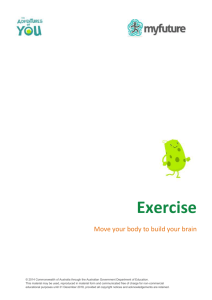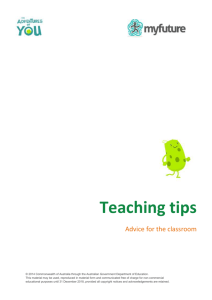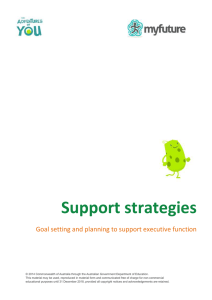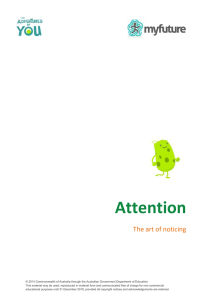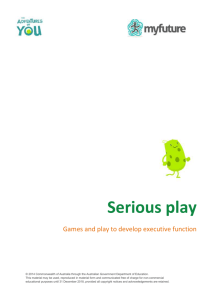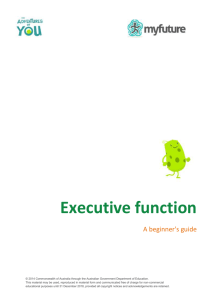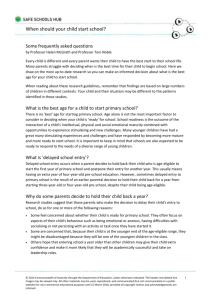Testing executive functions: a quick guide to free, online
advertisement
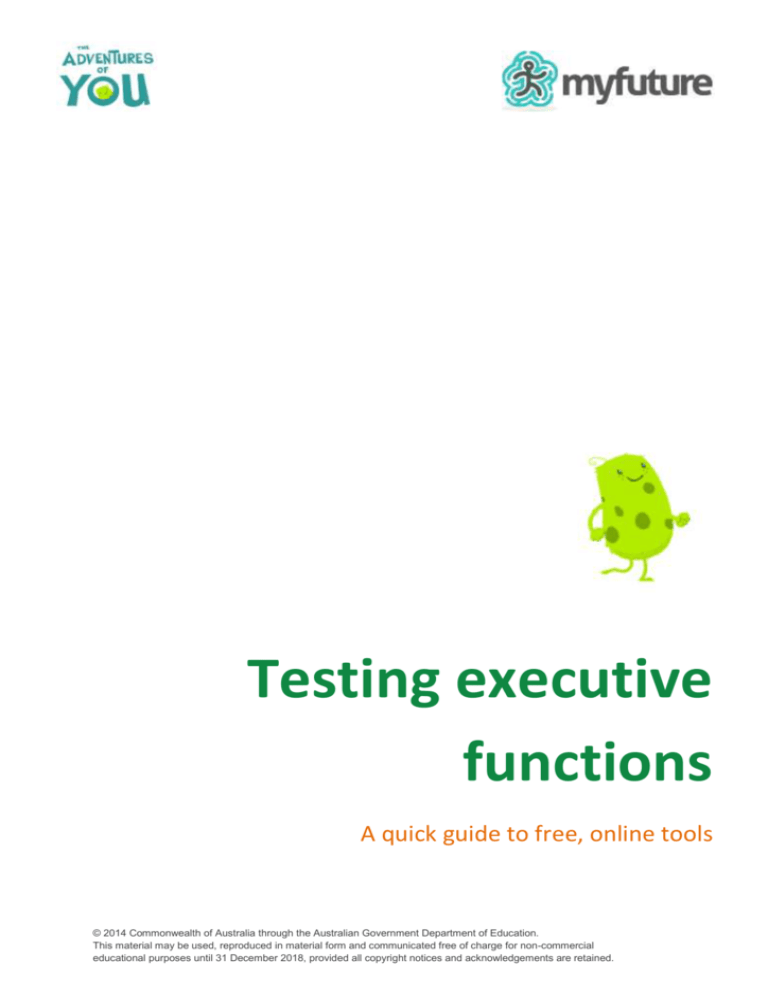
Testing executive functions A quick guide to free, online tools © 2014 Commonwealth of Australia through the Australian Government Department of Education. This material may be used, reproduced in material form and communicated free of charge for non-commercial educational purposes until 31 December 2018, provided all copyright notices and acknowledgements are retained. Who is this resource for? Teachers who want to test their students' executive functions Parents who want to test their child's executive functions Individuals who want to test their own executive functions. Why test executive function? In The Adventures of You we encourage you to take an active approach to developing your executive functions. One big challenge with this is getting feedback. Say you go out and exercise every day – are your executive functions improving? How would you know? Building executive function is a long-term activity. Hopefully the activities that you engage in are so interesting or enjoyable that they become self-reinforcing, but feedback is always useful to keep you motivated. One way to check your progress is to test yourself. Researchers use a wide variety of tests to measure different executive functions, and some of the tests are freely available online in a form that allows you to track progress over time. In this guide we provide a brief overview of relevant tests and point you to some online resources. A grain of salt Researchers argue a lot about the various tests for executive function. Are they accurate? Are they effective? What do they actually measure? It's important not to get too obsessed with them or give them too much weight. Treat them as a curiosity. Remember that executive functions are complex and interdependent, and these tests only scratch the surface. Executive function tests Tests of impulse inhibition As we have discussed elsewhere, there are different types of impulse inhibition: delaying gratification, interrupting a routine behaviour, directing attention away from distractions and so on. Tests of impulse inhibition will typically focus on one type of inhibitory control. © 2014 Commonwealth of Australia through the Australian Government Department of Education. This material may be used, reproduced in material form and communicated free of charge for non-commercial educational purposes until 31 December 2018, provided all copyright notices and acknowledgements are retained. 2 Stroop task Simon task Flanker task A series of colour-words appear in colours that match or contradict the words themselves. Subject must take care to classify each word as a match or mismatch. Subject must perform different operations (such as pushing a particular button) based on the position of a given stimulus (such as the position of a circle on a screen). Subject is told to pay attention to a central stimulus while surrounding stimuli are presented to distract and confuse. Delay of gratification tasks Go/No-go tasks Subject is shown a reward and then asked to wait before receiving it (the famous 'marshmallow experiment'). Subject is told to repeatedly perform an action and is then intermittently given instruction to stop the action Tests of working memory Working memory is the ability to not just hold information in the mind, but also to manipulate the information in some way. Working memory tests typically provide sequences of information for recall – the more robust tests ask the subject to work with the information. Basic span tasks A simple test of short term memory is to provide a list of elements (numbers, names, objects) and then immediately recall them Corsi block test (or Automated Working Memory Assessment Coloured blocks are highlighted in a given sequence. Subject must repeat sequence. Dual n-back tasks Subjects must recall increasingly complex audio and spatial sequences Re-ordering span tasks An effective test of working memory is to provide a list of elements and then ask the subject to not only recall the elements but also reorder them in a meaningful fashion (eg by size, position or type). © 2014 Commonwealth of Australia through the Australian Government Department of Education. This material may be used, reproduced in material form and communicated free of charge for non-commercial educational purposes until 31 December 2018, provided all copyright notices and acknowledgements are retained. 3 Tests of mental flexibility Mental flexibility is usually tested using creative problem-solving tasks, or tests that involve switching between tasks. Tasks you can do by yourself Design fluency tasks These tasks involve creating unusual uses for objects. Think of an object and come up with as many uses for it as you can within a set period of time. Verbal fluency tasks These tasks involve producing verbal variations on a theme. Think of as many words beginning with a particular letter, or with a particular number of syllables, or similar. Category fluency These tasks see you naming elements that fit within one or more categories. List all the things that fly, or alternate between naming animals and machines. Tasks you can do with another person Tower of Hanoi and Tower of London tasks These are related puzzle-based tasks where the subject generally has to figure out how to move different-sized discs between different locations, in a particular order, in order to produce a stack where the discs are ordered by size Picture arrangement tasks One person gives a sequence of pictures (like a comic strip) to the other, who must attempt to arrange them in the correct sequence. Wisconsin card sorting task The subject is given a set of illustrated cards and must sort them into piles. The trick is that the subject is not told how to determine which cards go into which pile; they have to figure this out based on feedback from the tester. Then during the test the rule is changed, and the subject must figure out the new rule. Some words of caution re using tests Don't let young people become despondent because of test results. One of the key messages of The Adventures of You is that you can build your executive functions over time if you take the right approach. Early scores are often artificially low because the subject is learning the task. Early gains can be made simply by practising the task. Take tests again after 6–12 months to see if there is any improvement. © 2014 Commonwealth of Australia through the Australian Government Department of Education. This material may be used, reproduced in material form and communicated free of charge for non-commercial educational purposes until 31 December 2018, provided all copyright notices and acknowledgements are retained. 4 These tests are not a foolproof way to measure executive function. There are many limitations. The different executive functions tend to work in conjunction with each other, along with memory, emotions and the immediate experiences that we are having. So a far better measure of executive function is overall performance in life. Scientists are really interested how well people can use executive function to improve their own lives. However, the tests are a good way to explore the concept of executive functions and get a stronger sense of how these functions work. For parents, teachers and carers While it might be fun to take some tests and track results over time, there is even greater value in the topics the tests provide for discussion with your children or students about how their brains work. Resources Websites Wikipedia, 'Neuropsychological test' contains background information about many executive function tests. http://en.wikipedia.org/wiki/Neuropsychological_test#Executive_function Cognitive fun is a site of unknown origin that presents a number of free cognitive tests including 'Go/No go', 'Dual n-back' and a variety of span tasks. It also lets you create an account and track progress over time. http://cognitivefun.net Tower of Hanoi is a classic planning puzzle, easily found online. http://www.mathsisfun.com/games/towerofhanoi.html CogTest is a company that provides cognitive testing tools. None are freely accessible, but there are many samples if you are interested in seeing how they work. http://cogtest.com/coglib_demtest.html Cambridge brain sciences is a site established by Cambridge University and the UK's Medical Research Council. It provides free cognitive ability tests grouped around memory, reasoning, concentration and planning. Even better, the site lets you create an account, track your data over time and compare yourself to everyone else who has taken the site's tests. http://www.cambridgebrainsciences.com © 2014 Commonwealth of Australia through the Australian Government Department of Education. This material may be used, reproduced in material form and communicated free of charge for non-commercial educational purposes until 31 December 2018, provided all copyright notices and acknowledgements are retained. 5 Sources of information Diamond, A 2013, 'Executive functions' Annual review of psychology, 64, 135–168. Chan, RC, Shum, D, Toulopoulou T & Chen, EY 2008, 'Assessment of executive functions: Review of instruments and identification of critical issues', Archives of clinical neuropsychology, 23(2), 201–216. Burgess, PW, Alderman, N, Evans, J, Emslie, H & Wilson, BA 1998, 'The ecological validity of tests of executive function', Journal of the international neuropsychological society, 4(06), 547–558. Chaytor, N, Schmitter-Edgecombe, M & Burr, R 2006, 'Improving the ecological validity of executive functioning assessment' Archives of clinical neuropsychology, 21(3), 217–227. © 2014 Commonwealth of Australia through the Australian Government Department of Education. This material may be used, reproduced in material form and communicated free of charge for non-commercial educational purposes until 31 December 2018, provided all copyright notices and acknowledgements are retained. 6
